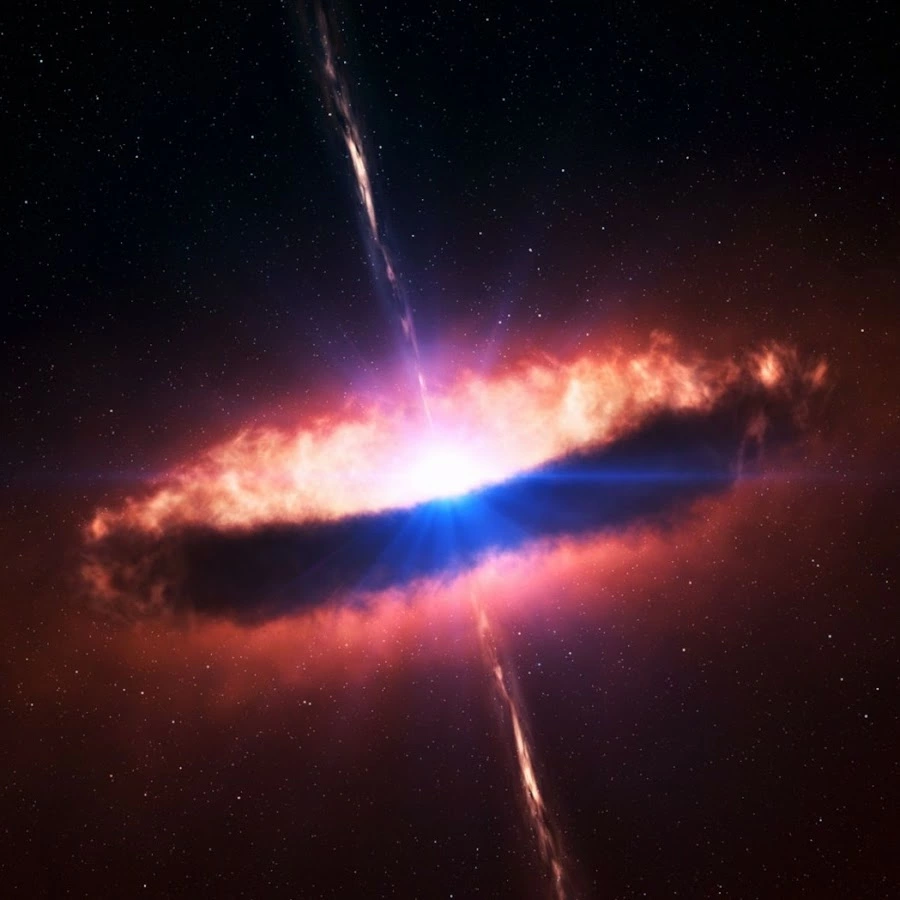Researchers have detected one of the most powerful cosmic rays ever seen slamming into Earth — but they have no idea what caused it or where it came from. The extremely energetic particle, which has been named after a Japanese goddess, arrived from the direction of a void in the universe where almost nothing is known to exist, according to new research.
Cosmic rays are highly energetic particles, mainly consisting of protons or helium nuclei, that are constantly raining through every square inch of the universe (including our bodies). But a small subsection of cosmic rays, which hit Earth roughly once per square mile every year, are accelerated to even greater energy levels by some of the universe’s most intense phenomena.
These extra-energetic particles, known as “ultra-high-energy cosmic rays,” have at least one exa-electron volt (EeV), or 1 quintillion (1 followed by 18 zeros) electron volts, of energy, which is around a million times more energetic than the fastest particles from human-made particle accelerators.
On May 21, 2021, researchers detected one of these supercharged cosmic rays with the Telescope Array project — a detector made of individual substations covering more than 270 square miles (700 square kilometers) in Utah. This particular particle had a whopping 244 EeV of energy, which makes it the most energetic cosmic ray since the “Oh My God” (OMG) particle in 1991 — the most powerful cosmic ray ever detected, which had an energy of 320 EeV and traveled at more than 99.9% the speed of light.
They named the mysterious particle “Amaterasu” after the sun goddess from the Shinto religion who is believed to have helped create Japan.

Seems like a good way to get smited, naming random (probably evil) energy that came from nowhere space (but not the sun) after the head goddess of Shintoism. Maybe Susanoo or Orochi would have kept the theme while not angering a top tier god.
Is it catching a frisbee?
The symbol of Japanese flag is a red frisbee
It’s part of Amaterasu, it’s like attached to his back or something in Okami.
So the hidden Earth village is being attacked by Sasuke…
Looks like the god from okami.
Amaterasu is the goddess from Okami
I imagined so but it’s not something I’m familiar enough with to say without looking into it.
Literally a picture from the game.
It’s certainly similar to the box, but I dunno man I played it once lol.
Saying the OMG particle was traveling more than 99.9% of the speed of light is a bit like saying the volume of the sun is greater than 1 cubic meter. It’s not false but Really undersells the real number, which is even listed in the article they linked about it: 99.99999999999999999999951% of C.
Could be a bunch of stuff that was hyper-accelerated by slingshotting off a black hole. Those are difficult to detect at the best of times, it would make sense if that void was just full of the things.
Maybe the facts that the beam is so energetic and that it comes from a seemingly empty spot are closely related. Law of squares. If the remains of the beam that arrive here are still the strongest ever measured, guess what power that beam had a gazillion lightyears away, and what such a powerful beam might have done to anything existing there.
It wasn’t a beam, it was a single particle slamming into the atmosphere. When it comes to particles like this, it’s yes/no on whether they arrive. They don’t lose energy as they travel.
As for the source, it would have been energetic to say the least. Less sterilising planets and more eating large stars like smarties.
Amusingly the actual energy was around 4 joules. An obscene energy for a particle, but tiny on human standards. (About 1 second of phone battery usage)
Yea, “beam” was a misnomer from my side. I basically meant “whatever part from that source hit us”. It could just be an absolute singular event, accellerated by a cosmic cataclysm or doing a swing-by maneuver around an event horizon. I simply assumed an omnidirectional source.
When it comes to particles like this, it’s yes/no on whether they arrive. They don’t lose energy as they travel.
They don’t? As my physics teacher once said: “Gravity does not sleep.” Any particle with mass interacts with the rest of the Universe (within limits, OK), so it can be assumed that it actually lost energy on the way. Which, in a way, makes it even more scary.
The “far away” thing was about particles spreading to the law of square, and how many of those particles near the source where they would be much more common could do to whatever had been there. Imagine something like Earth getting hit by, e.g. a bucket full of this “stuff”.
4J is a lot for a single particle, where one usually thinks in multiples of 1.6x10⁻¹⁹J…
Agreed on all points.
The gravity drag would be tiny however. The gravitational gradient in deep space is tiny, it’s being dragged forward almost as much as backwards. Further, (with a 2 mass approximation) it’s reliant on both masses. The equivalent mass of a photon is via E = MC^2 . Therefore M=E/C^2 . Plug the numbers and this Uber photon weighs 4.45x10^-17 kg. Stupidly huge for a subatomic particle, stupidly tiny for a relativistic mass.
Depending how far it’s travelled, it likely has more loss from the universe expanding. Unfortunately, I can’t remember the equations for that however.
The main point is that, beyond these effects, there is no slowdown. It either flies at full speed, or hits something and creates a cascade of far slower (boring) particles.
Thanks! I learned a lot in this discussion!
Or its empty because nothing filled it yet, and we are seeing the first bursts of a new event. Birth of a star, or some other grand spacial phenomena
A new chunk being loaded into RAM
AFAIK “first burst of a star” is sufficiently understood not to cause that kind of energy level.
The universe is often estimated to be pretty young. Maybe its a type of star formation we have never seen before.
Or maybe its the birth of something else, that previously was extremely rare or hard to see.
Empty space lacking things just seems more likely to be pre-start rather than post-end, from what I understand about reality’s overall age and makeup.
Stars don’t pop into existence from nothing. They form from large clouds of gas. We also understand physics enough to know how that interaction happens to know that isn’t it. Physics has been studied for a long time. Unexplained things usually aren’t explained by simple guesses. It’s probably something either much stranger, or much more mundane, like an error somewhere.
Im assuming when the post says “empty,” they are meaning “empty of light,” since we cannot know the space is genuinely devoid or just not sending detectable radiation our direction.
Im also pretty sure that a particle we have never seen before acting in a way we’ve never seen before is likely going come from a phenomena we’ve never seen before. After studying physics for a long time, we know that new ways to do things we previously thought we understood all the ways to do are discovered when we keep studying physics.
My point wasn’t that it isn’t something new, it’s that it probably isn’t something that simple.
Gas clouds are devoid of visible light often, but they still emit electromagnetic radiation (aka light). It’s pop-science, so who knows what their meaning of words is, but a gas cloud would not be empty, and stars can’t come from nothing. Also, presumably, we’d detect the star formation afterwards. Instead of a star it could be a direct collapse black hole (which we don’t know for sure if this is even possible), which would be harder to detect after, but would still have to form from an even denser gas cloud, so even more EM radiation would be coming from it. Regardless, it’s probably not something like this, assuming they used a reasonable definition of the word “empty”.
You will notice I explicitly said lacking radiation. You will also notice nothing I suggested was even mildly simple.
My comment was not subtly implying that this particle would be a forerunner of an event, moving far ahead of traditional radiation. This would be the beginning of detecting the afterwards.
I also was very clear that I thought it was the birth of a phenomena, and named a new type of star birth as an example of one such possibility.
I do find it kinda funny that youre telling me Im wrong by repeating my comments back to me
Good observation. You may be on to something
Will this give the gay furies their cat transformations so they leave our power plants alone?
I love how this reads like /c/aneurysmposting , but you’re just referencing that crazy ass news sorry of those hackers making wild demands
and not a popular joke here it would seem lol
Less popularity, more just immensely obscure
Hey you ended up back on top nonetheless haha
This has been quite the adventure
I’ll take “Sentences That Wouldn’t Have Made Sense A Week Ago” for $800, Alex.
Wish granted.
No longer in need of nuclear plants, the furries have now forsaken them. Because of this, no one is left to maintain the software used in them. With the lack of this technology, all nuclear plants rapidly fall into a state of pending meltdown.
I think the software itself is gold standard and does not change, so that wouldn’t be the case. The technitians, on the other hand… are not something you can get from your corner store.
Willing to bet more people play in the NFL than are qualified to do that job…
It came from space I think
traveled at more than 99.9% the speed of light.
Oh come on. I’m all for shorthands, but 99.9% is child’s play that can be accomplished in very modest linear accelerators. The OMG particle was traveling at 99.99999999999999999999951 % c.
Come on y’all!
Cosmic rays coming from a void, known to be empty? Ultra-powerful ‘goddess particles’? Raining through our bodies?
In all fairness to science, but we all know what comes next.
science is literally just made up to cover up the existance of gnomes and gnome magic
i gnew it
That’s just what a faerie would say
Gnome
magictechnology.Holly Short will be with you shortly, along with some memory erasers equipped with the best tech from Foaly himself. Don’t resist.
This one was just for targetting and the real blast turns us all toasty?
Like a jihadi when the room is suddenly filled with green laser light
😳
no idea why people are downvoting this but I’m jumping on the bandwagon
Space maaan.
I always wanted you to go 🎶
You know what I hope is in space? Fire. I hope you go to space and catch on fire.
You catch on fire when you go back, you know
One could argue that the veracity and transcendence of such event won’t be defined by social media votes. So, vote away my friend.
Because hyper-sensationalized pop-science is annoying would be my guess.
This reads like a shitpost. Empty void? OMG? Is this real??
Sometimes science can get a bit silly. The OMG particle literally got its name because someone circled some data and wrote “OMG!” beside it… And then people just kept referring to it that way.
Geez what a stupid clickbait title
deleted by creator













